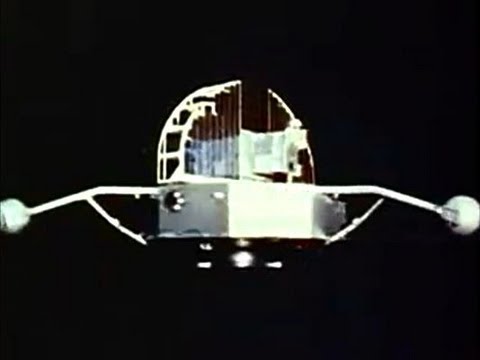more at
“This film shows how the tools of research in near-earth space have progressed since Benjamin Franklin’s time to the sounding rockets and unmanned earth-orbiting satellites of today. It pictures the type of data that was being collected by National Aeronautics and Space Administration (NASA) from its space excursions and its solar, astronomical, and geophysical observatories. It also includes animated sequences. This film takes a broad look at physics and astronomy research performed in the laboratory of space — a laboratory teeming with particles, fields, streams, flares, quasars, and pulsars.”
Text transcript:
NASA film HQ-207
Public domain film from the National Archives, slightly cropped to remove uneven edges, with the aspect ratio corrected, and 1-pass exposure & color correction applied (cannot be ideal in all scenes).
The soundtrack was also processed with volume normalization, noise reduction, clipping reduction, and/or equalization (the resulting sound, though not perfect, is far less noisy than the original).
The Knowledge Bank — 1971
Narrator: Today we have an incredibly sophisticated scientific laboratory in space. OSOs, OGOs, OAOs, IMPs, RAEs, and other scientific satellites carry the experiments of famous scientists from many nations. This achievement can only be understood by measuring it against generations of scientific endeavor. Let’s step back to that rainy day in 1752, when a great American put a scientific deposit in the bank of knowledge. He identified lightning with electricity, though of course he had no way of understanding how to use its power. Over the next century, other deposits were made, until one day the discoveries poured in so fast that the sum of knowledge became enormous. Faraday discovered how to build a motor. Wilhelm Roentgen was experimenting with a strange force which he named X-rays. Almost at the same time, Thomas Edison cashed in on Ben Franklin’s deposits in the knowledge bank as he discovered how to light a bulb, starting the age of electricity. Science continues this way.
The deposits may seem small, but the interest is enormous and the payoff is frequently beyond even the range of science fiction.
Today’s Franklin stands in the shadows of a launch control room, watching his instruments roar aloft to gather knowledge for the bank. The tools of investigation have changed since Franklin’s day, but the methods have not. His kite is a spacecraft, his key a cosmic ray detector or a miniaturized mass spectrometer, his string the stream of data linking the experiments with the ground station.
Space science is science done in space. The laboratory has become enormous. Space science began with the first balloon carrying photographic film to detect cosmic rays above the curtain of the atmosphere. These balloons investigated the first 35 miles up, the troposphere and stratosphere, as we call them. Beginning in 1945, scientific sounding rockets began mapping the ionosphere, that is, from about 35 miles up to about 1,000 miles. Sounding rockets do not orbit like satellites; instead they take an important vertical sample of the upper atmosphere and also make measurements at altitudes too low for satellites. It was experiments on sounding rockets that first discovered X-rays from the Sun and first observed the Earth’s enormously complex cloak of charged particles, the ionosphere. In 1958, the Van Allen team, their experiments riding on the first satellite, Explorer 1, discovered great seas of intense radiation swirling about our fragile spacecraft Earth.
Since 1958, nearly 150 satellites, to say nothing of over 1500 sounding rockets, balloons, and high-flying aircraft, have mapped the Earth’s environment in space in ever-increasing detail. High altitude satellites concentrated on what came to be known as the magnetosphere, a vibrant, turbulent teardrop shaped by the million mile per hour solar wind, tormented by severe turbulence on its shock front and buffeted into a streaming tail stretching millions of miles away from us, away from the Sun. This enormous sea of charged particles and magnetic fields is affected by every mood of the Sun. And when the Sun flares up, its energy interacts vigorously with the magnetosphere, the ionosphere, and the atmosphere in very noticeable ways…

